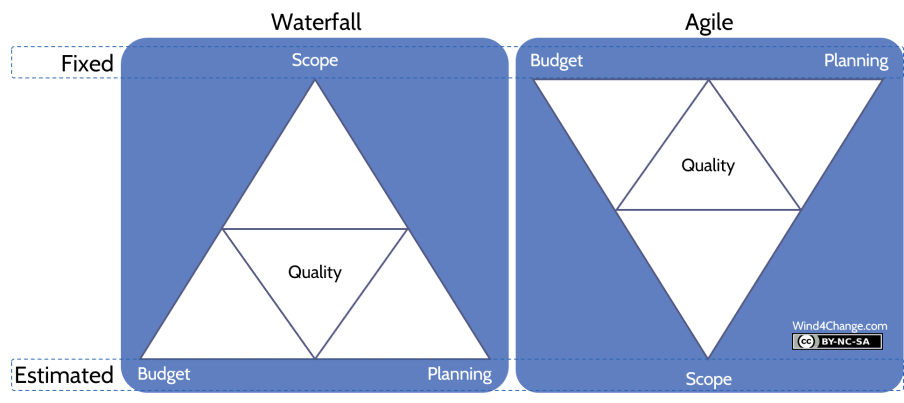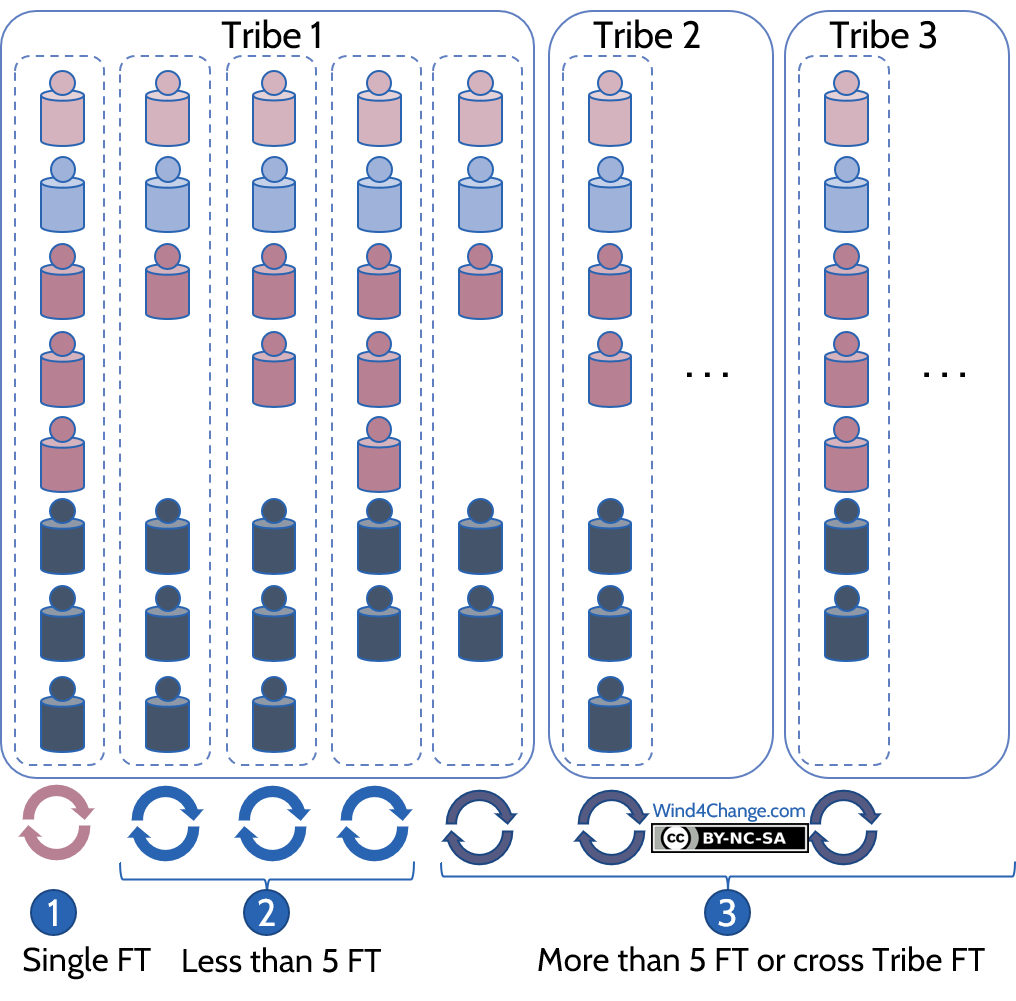What are the changes in Project Management with Agile and Agile at Scale? And how does the paradigm on scope, budget, planning change with Agile? At last, what is the proper Project Management set up based on the level of dependencies between the Agile Squads?
- What is project management?
- What are the changes coming with Agile and Agile at Scale impacting Project Management?
- How to address Project Management in an Agile environment?
- When is there a need for a Project Manager?
- What’s next? Learn more about Agile at Scale
- Some valuable references on Project Management
What is project management?
Project management is the practice of initiating, planning, executing, controlling, and closing the work of a team to achieve specific goals and meet specific success criteria at the specified time.
A project team is a team the members of which usually belong to different groups, have different functions, and that the project manager assign to activities for the same project.
What are the changes coming with Agile and Agile at Scale impacting Project Management?
Agile comes with a change of paradigm: from scope fixed to time boxing

With Agile there is a change of paradigm. Even if the teams are still application oriented as it is the case at the beginning of a transformation, the team switches delivery from a fixed scope to a budget (capacity) and a planning (time period) that are fixed. The objective is no longer to make sure that the team delivers the contracted scope but to maximize value within the fixed capacity and time. There is still a vision of what the project stakeholders expect but as the team with the Product Owner learn, they adapt the delivery to maximize the value.
Agile at Scale comes with an alignment of the organization, Agile Squads, Tribes on Value Chains: this decrease dependencies to build products

In addition to fixed scope, and estimated budget and planning, another complexity that traditional project management tries to address is that contributors are coming from many places and some of them are not full time on the project. Surely, there is a need to make sure that contributors will deliver on time and on quantity. Without a doubt, Agile at Scale simplify this complexity aligning Agile Squads and Tribes on Value Chains and Products.
This alignment is some time partial and there is still a need to manage contributions: this is where there is a need for project management. Nevertheless, it does not always require a dedicated person.
How to address Project Management in an Agile environment?
To answer the question, let’s review the project activities as covered by the PMI area of knowledge grouping them by actors who deliver them in Agile.
The pair Product Owner and Scrum Master deliver some activities. Then the PO manages some of them alone. At last, some activities may require additional contributors when mentioned.
For perimeters with multiple Agile Squads, Product Management Team involves to cover the whole perimeter with an Scrum Master taking the lead. The Product Owners still manage the activity at the level of their Agile Squads aligned with the Product Management Team guidelines. Clearly, what will trigger the assignment of a dedicated Project Manager is the level of complexity that may not be manageable as a side activity.
Activities delivered by the pair Product Owner and Scrum Master
Project Integration Management (part 1)
Identify dependencies and time constraints on a demand. Alignment coming with Agile should limit dependencies and constraints but if there is a need, the Product Owner identifies them for the business side and the Scrum Master for the IT side.
Project Integration Management (part 2)
Enforce synchronization if various teams. If the Agile Squad is autonomous, Agile at Scale ceremonies and artifacts address the need. In addition, a part time role of Project Manager addresses ad hoc contributions outside the synchronized Agile Squads. In fact, one of the Scrum Master of the perimeter usually takes the lead and plays this role.
Project Quality Management
The team(s) and Scrum Master(s) follow the quality by the flow for each sprint and release.
Project Resource Management
Organize and manage the project team. Agile at Scale ceremonies and artifacts address this activity.
Project Communication Management
The team(s) and Scrum Master(s) address it recurrently based on sprints and releases.
Project Risk Management
Agile at Scale ceremonies and artifacts also support this aspect. In addition to initial identification of risks, backlog refinement and prioritization are key practices to identify and mitigate risks.
Project Procurement Management
This activity requires the contribution of the application referent(s) in charge of the application(s) involved. This role is describe in the post about reallocation of roles.
Project Stakeholder Management
Identify and onboard those impacted by the project. As we have seen before, alignment reduce ad hoc contributions outside the synchronized Agile Squads. The part time role of Project Manager addresses this topic.
Project Cost Management
Capacity is fixed for a time period then cost. As a matter of fact, the Chapter Manager takes care of the hiring activity in Agile at Scale model. See the post about Chapter and Guild for more detail.
Activities delivered by the Product Owner with support of the Scrum Master
Project Scope management
Switches from ensuring “scope is delivered” to enforcing “value delivered is maximized“.
Project Schedule Management
Switches from ensuring “scope is delivered” to enforcing “value delivered is maximized”. Some initiatives (Agile Epics) or Features may be time bound and require a specific follow up to be delivered before the deadline.
When is there a need for a Project Manager?

Current roles address the need for project management: the case of autonomous Agile Squad or multiple Agile Squads with a middle level of complexity
- When an Agile Squad is autonomous, the Agile Ceremonies cover the need of project management. In addition, the Scrum Master manages ad hoc contribution as a marginal activity. For organization that are still application oriented, as the number of contributions may be important, there may be a need for a dedicated Project Manager.
- For a group of Agile Squads working on the same Value Chain, usually Agile at Scale Ceremonies facilitated by one of the Scrum Master address the need for synchronization and alignment. Moreover, the other Scrum Masters contribute. But if the complexity is too high, there may be a need for a dedicated Project Manager.
There is a need for a dedicated Project Manager role: the case where the number of Agile Squads is too important and/or the complexity is too high
3. In some case, alignment cannot help as by nature an initiative may be across Value Chains, then across Tribes and Agile Squad. To illustrate, the typical example is the compliance program impacting all the company. In this case, a Program is set to manage the initiative with a dedicated role of Project Manager. As far as possible, contributors are dedicated and gathered as Agile Squads or if not possible as individuals. Major framework used in this case is SAFe.
3bis. The complexity may be too important also for a given initiative aligned on a Value Chain. In this case, like for a transverse initiative, a dedicated Project Manager helps to manage the complexity.
4. At last, when there is a need for specific reporting that goes beyond Agile at Scale purpose of ceremonies and artifacts, there may be a need for a dedicated person for project management.
See my other post on Agile at Scale synchronization mechanisms.
What’s next? Learn more about Agile at Scale
Check my other posts about Agile at Scale:
- Review my posts on Agile at Scale foundations:
- What are
- What are the team topologies?
- How to synchronize Agile Squads in Agile at Scale when there are dependencies?
- Check another of my posts introducing Agile at Scale that leverages the book “Doing Agile Right”.
- Review my post on the Agile best practices from the GAO the Government Accountability Office from the USA.
- Read my posts on advanced topics around Agile at Scale:
- What are Leagues in Agile at Scale?
- How to design Agile Squads so they are aligned on the Value Chains.
- Why going for horizontal management? What does it mean and what is the value?
- How roles are reallocated with Agile at Scale?
- Check my posts on project management in Agile at Scale
- What is the impact of Agile on Project Management?
- How does Project Portfolio Management change with Agile at Scale?
- Then, how does Cost of Delay Divided by Duration (CD3) contribute to Agile at Scale?
- How does Beyond Budgeting support Agile at Scale?
- Can an Agile Project be fixed price?
- How to manage Release Management in Agile?
- Review my posts on how to forge a good strategy:
- What are competition and competitive advantage?
- What is a good strategy?

Good writting
Thanks for your comment. I am happy to read that you have appreciated my blog material.